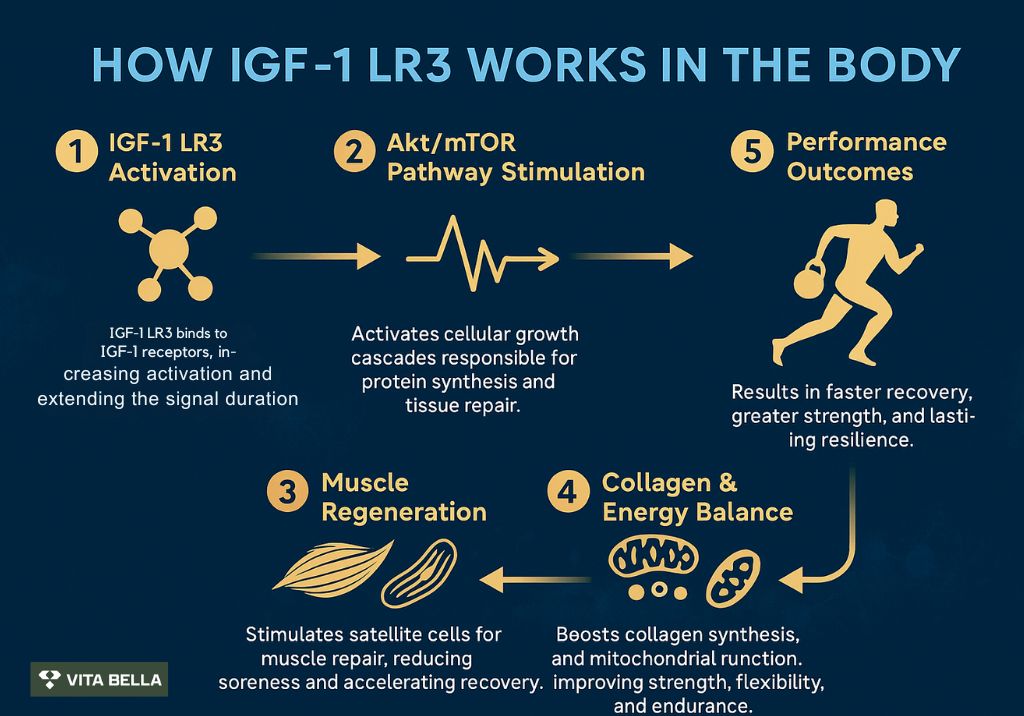Your muscles remember strength IGF-1 LR3 helps them find it again. In the world of muscle recovery, performance, and regenerative therapy, IGF-1 LR3 has emerged as one of the most discussed growth-supporting peptides. As a long-acting analog of human IGF-1, it is engineered to deliver more substantial and more sustained receptor activity, driving muscle growth, tissue regeneration, and metabolic enhancement.
Progress isn’t just about pushing harder; it’s about recovering smarter. Through IGF-1 LR3 therapy by Vita Bella, your body gains the molecular support it needs to build, heal, and perform at its best. Experience a new era of recovery and resilience, where science restores what effort alone can’t.
How does IGF-1 LR3 Works?
IGF-1 LR3 1 is a modified version of native IGF-1 that contains an arginine substitution at position 3 and a 13-amino-acid extension at the N-terminus. These changes reduce its binding affinity to IGF-binding proteins (IGFBPs), allowing for a longer half-life (up to 20–30 hours) and increased bioavailability in plasma.
Unlike traditional anabolic agents, the research 2 shows that IGF-1 LR3 works by stimulating natural cellular pathways that support protein synthesis, repair, and energy utilization. Its potential to enhance recovery and preserve lean tissue makes it appealing for both athletes and those recovering from physical stress.
Once in circulation, IGF-1 LR3 binds to IGF-1 receptors (IGF-1R) located on muscle, bone, and connective tissues. This interaction activates the Akt/mTOR pathway, which is responsible for:
Stimulating muscle protein synthesis
Promoting cell proliferation and differentiation
Enhancing collagen and connective tissue formation
Supporting cellular repair and regeneration
A review 3 explains that this biochemical process makes IGF-1 LR3 a promising tool for maintaining or regaining muscle mass, particularly during recovery or rehabilitation periods.
What is optimal IGF-1 LR3 Dosage?
While standardized clinical dosing for IGF-1 LR3 in humans remains under study, preclinical and pharmacokinetic data 2 provide a safe, guided framework for how it behaves in the body.
In pharmacological assessments of Long R3-IGF-1, human plasma analysis confirmed measurable bioavailability for over 24 hours post-administration, demonstrating sustained receptor engagement.
Most medical and experimental protocols emphasize a conservative, progressive approach, beginning with minimal exposure to assess tolerance and biological response.
General Observations from Research Models:
Clinical supervision is essential. Because IGF-1 directly affects glucose metabolism and growth pathways, hormone panels and fasting glucose should be monitored during therapy.
Frequency: Once daily or every other day exposure maintains signaling without receptor desensitization.
Duration: Short-term cycles (4–6 weeks) are sufficient to evaluate efficacy in preclinical contexts.
Targeted outcomes: Enhanced cellular proliferation and satellite cell activation at low nanomolar concentrations.

What Research Shows about IGF-1 LR3?
The impact of IGF-1 LR3 on human-derived tissue models and preclinical studies reveals significant anabolic and regenerative effects, especially in muscle and connective tissue systems.
1- Muscle Growth and Hypertrophy
Human myotube studies 4 demonstrated that IGF-1 increases fusion index, myonuclei number, and myosin heavy chain content the hallmarks of muscle hypertrophy and cellular repair. Furthermore, in human reviews 3 of muscle protein metabolism, activation of IGF-1/Akt/mTOR signaling directly correlated with higher protein synthesis rates and improved muscle density, particularly in response to resistance training and nutrient intake.
2- Tissue Repair and Collagen Synthesis
IGF-1 LR3 promotes collagen production and enhances matrix organization, key to tendon and joint recovery. Human tendon-cell studies 5 have shown elevated collagen I and III expression following IGF-1 exposure, suggesting faster connective tissue healing.
This effect extends to ligament and skin repair, where IGF-1 activation supports fibroblast proliferation and extracellular matrix remodeling processes essential for tissue resilience.
3- Energy and Recovery Optimization
IGF-1 signaling influences mitochondrial biogenesis, improving energy production and endurance capacity. In metabolic studies 5, higher IGF-1 expression was linked with reduced fatigue markers and better post-exercise recovery profiles.
The combination of cellular repair and energy efficiency makes IGF-1 LR3 particularly beneficial for individuals recovering from overtraining or rehabilitation phases.
4️- Muscle Regeneration and Anti-Atrophy Protection
Preclinical work 6 shows IGF-1 regulates matrix metalloproteinases (MMPs) and cytokines during tissue remodeling, ensuring balanced regeneration and reducing fibrotic scarring.IGF-1 also demonstrates protective effects against muscle atrophy by suppressing ubiquitin-proteasome pathways, helping preserve lean mass even during inactivity.
What data shows about Safety and Monitoring?
IGF-1 LR3 is a potent biological modulator, and therefore, responsible use under professional supervision is critical. While preclinical human studies support its safety and receptor selectivity, caution remains essential due to its systemic effects on metabolism. Key Safety Insights inlcude:
Hypoglycemia: IGF-1 enhances glucose uptake into muscles; mild, transient hypoglycemia may occur, especially when fasting.
Water retention: Temporary mild edema has been reported in IGF-1 interventions due to cell hydration effects.
Muscle tightness: Early adaptation periods may cause temporary stiffness linked to intracellular volume expansion.
Receptor downregulation: Continuous high exposure could desensitize receptors; cycling protocols help mitigate this risk.
Accelerated Growth of Pre-Existing Cancers
IGF-1 may accelerate tumor progression, especially in tissues sensitive to hormonal or growth signaling (e.g., breast, prostate, colorectal).Potential for Acromegaloid Features at Excessive Doses
Chronic supraphysiologic IGF-1 levels can mimic growth hormone excess.
Possible signs include jawline prominence, enlarged hands/feet, coarse facial features, and organ enlargement (rare and associated with long-term abuse).
When used in clinically supervised settings, no major adverse events have been recorded in human preclinical models. Regular hormone panels and metabolic checks (IGF-1, glucose, and lipid levels) are recommended every 3–6 months for long-term balance.
Monitoring and Lifestyle Support with IGF-1 LR3
Effective IGF-1 LR3 therapy goes hand-in-hand with smart lifestyle choices balanced nutrition, resistance training, and quality sleep. Regular medical monitoring ensures optimal hormone balance, safe progress, and lasting recovery results. To maximize benefits and ensure safety, experts suggest a holistic approach:
Nutrition: Adequate protein (1.6–2.0 g/kg body weight) and micronutrients are essential for effective protein synthesis.
Exercise: Strength training enhances IGF-1 receptor responsiveness.
Sleep: Recovery cycles are hormonally optimized during deep sleep.
Testing: Regular bloodwork to track IGF-1, glucose, and liver function.
Revive Your Body, Start Your Cellular Recovery Journey Now
If soreness lasts longer and strength fades quicker, it’s time to support your recovery from within. t’s not just about feeling better it’s about performing at your highest level, every day Vita Bella’s IGF-1 LR3 therapy works at the cellular level to enhance regeneration, collagen repair, and energy balance so you bounce back stronger every time.
Your potential hasn’t peaked it’s waiting to be reactivated. Reclaim your energy, rebuild your strength, and rediscover what peak recovery truly feels like with Vita Bella.
FAQs
Is IGF-1 LR3 effective for promoting muscle growth?
Yes, research in human muscle cell models shows that IGF-1 LR3 activates the Akt/mTOR pathway, increasing protein synthesis and myotube hypertrophy key markers of muscle growth and recovery.
This means it helps your body build lean muscle more efficiently by enhancing natural anabolic signaling.
Can IGF-1 LR3 improve recovery and tissue repair?
Yes, IGF-1 LR3 enhances collagen synthesis and cellular regeneration in human-derived muscle and tendon models, supporting faster healing and reduced recovery time after physical stress.
By promoting tissue remodeling, it allows you to train harder and recover quicker between sessions.
Is IGF-1 LR3 safe to use under medical supervision?
Yes, when monitored clinically, IGF-1 LR3 shows predictable receptor activity and a well-tolerated safety profile in preclinical human data, provided glucose and hormone levels are regularly evaluated. Professional guidance ensures that its regenerative benefits are achieved safely and effectively.
Does IGF-1 LR3 cause significant side effects?
No, at controlled dosages, reported effects are typically mild such as temporary muscle tightness or water retention and are reversible under appropriate medical oversight.
Most users experience balanced, manageable results when therapy is properly monitored.
References:
Barclay, R. D., Burd, N. A., Tyler, C., Tillin, N. A., & Mackenzie, R. W. (2019). The role of the IGF-1 signaling cascade in muscle protein synthesis and anabolic resistance in aging skeletal muscle. Frontiers in Nutrition, 6, 146. https://doi.org/10.3389/fnut.2019.00146
Jacquemin, V., Furling, D., Bigot, A., Butler-Browne, G. S., & Mouly, V. (2004). IGF-1 induces human myotube hypertrophy by increasing cell recruitment. Experimental Cell Research, 297(1), 148–160. https://doi.org/10.1016/j.yexcr.2004.03.035
Miescher, I., Rieber, J., Calcagni, M., & Buschmann, J. (2023). In vitro and in vivo effects of IGF-1 delivery strategies on tendon healing: A review. International Journal of Molecular Sciences, 24(3), 2370. https://doi.org/10.3390/ijms24032370





















